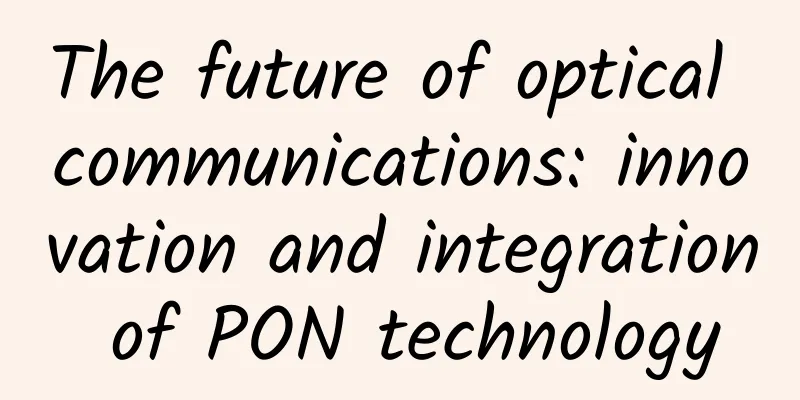The future of optical communications: innovation and integration of PON technology

|
Author | Heye Review | Chonglou With the continuous development of information and communication technology, optical communication technology has become increasingly popular as a means of communication with high bandwidth and low latency. In optical communication technology, Passive Optical Network (PON) technology, as an efficient and energy-saving optical fiber access technology, is gradually becoming one of the mainstreams of future optical communication networks. This article will start from the development and principles of PON technology, introduce the development direction of PON technology in related fields , and look forward to the future development of PON technology in combination with IT technology. 1. Development and Principle of PON TechnologyPassive Optical Network (PON) technology is a passive optical network technology. Its basic principle is to transmit signals through optical fiber. The optical line terminal (OLT) sends data to the user terminal device (ONU), and the optical network unit (ONU) receives and forwards data to the end user device. PON adopts point-to-multipoint (P2MP) access mode, saving trunk optical fiber and optical module. The central office optical fiber leads to multiple optical fibers to the home after passing through the optical splitter, saving optical fiber resources. The main advantage of PON technology is that it does not require power reinforcement, reduces maintenance costs, and supports large-scale user access . PON technology has gone through multiple stages of development, from the initial APON/BPON to GPON, and then to the current 10G PON and XG-PON . With the development of PON technology, the network coverage has also expanded. EPON can cover 20 kilometers, GPON can cover 40 kilometers, and 10GPON can theoretically cover 100 kilometers. With the evolution of technology, the bandwidth and transmission rate of PON technology have gradually increased to adapt to the growing network needs. In the future, the next generation of fiber access technology based on PON technology will pay more attention to bandwidth, scalability and intelligence. Generally, the city network can be divided into two parts: access network and metropolitan area network. The entire PON network belongs to the access network, which realizes the interconnection between users. As shown in the figure, users use various interfaces provided by ONU to realize the access of video Internet services , data , and voice , and then connect to OLT through the optical splitter. OLT usually uses dual uplink to upload data to the broadband access server ( BRAS ) to realize link backup. When users go online, they need to use the 3A module of BRAS to implement authentication, authorization, and billing. Only users who pass the authentication can access the Internet. BARS can perform local authentication and remote authentication. The current network generally uses remote authentication and implements the authentication function through the RADIUS server. When users want to go online, they initiate PPPOE dial-up to reach BRAS. When BRAS is local authentication, it will verify the user name and password. After the authentication is passed, an IP address is allocated. Only when the ONU has an IP address can it access the Internet. In order to separate the incoming and outgoing signals of multiple users on the same optical fiber, the upstream data stream adopts TDMA technology to prevent collision, and the OLT allocates different time slots to each ONU; the downstream data stream adopts broadcast technology. The OLT sends signals in the form of broadcast, which are split by the splitter and distributed to different links. Each ONU can receive the broadcast message of the OLT at the same time, but the ONU will choose to receive its own information according to the ID assigned by the OLT during registration. Upstream data flow Downstream data flow 2. Development direction of PON technology in related fields1. 5G integration and applicationsWith the rapid development of 5G networks, PON technology has begun to explore deep integration with 5G. By combining the high speed of PON technology and the low latency of 5G networks, users can be provided with faster and more reliable communication services. In the future, as 5G commercialization advances, PON technology and 5G networks will be further closely integrated to bring users a better network experience. 2. Application of AI technology in PON networksThe application of artificial intelligence technology in the field of communications is increasing. In PON networks, AI technology can be used for network monitoring, fault prediction, resource optimization, etc. AI technology can help network operators better manage PON networks, improve the intelligence level of the network, and enhance the network's adaptive capabilities. 3. Intelligent ODN networkThe future development of PON technology will also focus on the construction of intelligent ODN networks. Intelligent ODN networks will greatly improve network management efficiency and user experience. Through intelligent technology, network operators can more promptly and accurately detect network faults and handle them, thereby improving network service quality and user satisfaction. 3. Future Prospects of PON TechnologyThere is a close connection and complementary relationship between PON technology and IT technology. The development of IT technology provides support for the intelligence and management of PON technology, while the high speed and stability of PON technology also provide a broader space for IT applications. In the future, PON technology will be deeply integrated with IT technologies such as AI, big data, and cloud computing to jointly promote the innovative development of optical communication technology. IV. ConclusionAs an important fiber optic access technology, PON technology will play an increasingly important role in future optical communication networks. Through continuous technological evolution and deep integration with IT technology, PON technology will bring users a more efficient and intelligent communication experience. In the future, with the continuous development of 5G and AI technologies, PON technology will continue to innovate and improve, becoming one of the important pillars in the field of optical communications. I hope that PON technology will continue to improve in the future and contribute to the construction of a smart and efficient communication network. About the AuthorHe Ye, 51CTO community editor, is responsible for communication technology and network operations in a communications company. He once worked as a development and testing engineer in an e-commerce software development department, mainly responsible for e-commerce business platform development and testing, as well as training NLP-related algorithm models. |
<<: From UML to SysML: The language journey of describing complex systems
>>: Real-time advertising recommendation system implemented by SpringBoot and Apache Doris
Recommend
[Black Friday] ZJI: Hong Kong Alibaba Cloud CN2 model 55% off monthly payment starting from 412 yuan
In order to welcome the upcoming Double 12 and ov...
Kunpeng gathers data, shines in the Central Plains, and promotes the digital economy
On September 25, the 2019 Digital Economy Summit ...
From East-West Computing to Computing-Network Integration, Mobile Cloud Empowers New Digital Development
With the booming development of the digital econo...
Keda releases global perception trinocular camera | one device can do three things
In all kinds of safe and bright construction For ...
After reading the long connection in HTTP protocol, most programmers collected it...
What is a long connection? Long connection or sho...
The Secret of Online Physical Examination Technology (Part 1)
1. Necessity of online physical examination In da...
Six key advantages of optical interconnect technology
We keep hearing about the construction of future-...
In the 5G era, will programmers lose their jobs or continue to be popular?
Recently everyone has been discussing such a thin...
Problems that edge computing needs to solve urgently
At present, edge computing has been widely recogn...
Why 5G and IoT security is more important than ever
[[421462]] The convergence of IoT and 5G is a gam...
I haven’t heard any news about 5G for a long time. Is the enthusiasm starting to fade?
With the development of communication technology,...
ElasticSearch IK Tokenizer Quick Start
1. Install IK word segmenter 1. Allocate a pseudo...
It’s time to understand HTTPS and the encryption behind it
HTTPS (Hypertext Transfer Protocol Secure) is an ...
5G is not yet popular, but 6G patents are already the world's first, and the 6G war has already begun
5G has been promoted for a long time, but it has ...
"Small body but great wisdom" Huawei helps Wanyang digitalize small and micro parks
[51CTO.com original article] How many "chara...









